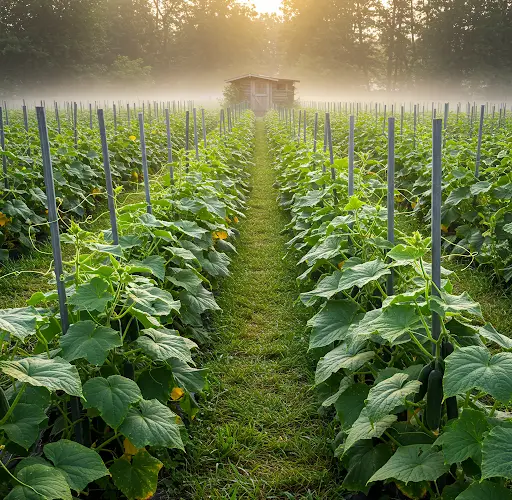The Best Cucumber Growing Methods for an Abundant, Crunchy Harvest
Cucumbers are a staple in many gardens, prized for their refreshing crunch and versatility in salads, pickles, and snacks. However, growing a highly productive cucumber garden requires more than just planting seeds and watering them. Many gardeners face challenges such as poor yields, bitter-tasting cucumbers, or weak vines. Fortunately, by following the right growing techniques, you can cultivate a thriving cucumber garden with an abundance of crisp, delicious fruits. If only I had known these methods earlier!
In this guide, we will explore the best cucumber growing methods to ensure a bountiful harvest of high-quality cucumbers.
Choosing the Right Cucumber Variety
The first step to achieving a successful cucumber garden is selecting the best variety for your needs. Some cucumber types produce larger yields and crunchier fruits than others. Popular varieties include:
- Marketmore 76 – A widely grown variety known for its disease resistance and crisp texture.
- Straight Eight – Produces smooth, straight cucumbers with excellent crunch.
- Lemon Cucumber – A unique, round cucumber with a mild, sweet flavor.
- Boston Pickling – Perfect for making pickles due to its firm texture and small size.
Choosing a variety suited to your climate and garden space will maximize your harvest.
Preparing the Soil for Cucumber Success
Cucumbers thrive in well-draining, nutrient-rich soil with a slightly acidic to neutral pH (6.0 to 7.0). Proper soil preparation is essential for healthy vine growth and fruit production.
Steps for Soil Preparation:
- Test the Soil: Check for pH and nutrient levels using a soil test kit.
- Enhance Drainage: If your soil is heavy clay, mix in compost or sand to improve aeration.
- Add Organic Fertilizer: Incorporate compost, aged manure, or balanced organic fertilizer to boost soil fertility.
- Mulch the Beds: Apply mulch to retain moisture, prevent weeds, and regulate soil temperature.
Optimal Planting Techniques
Cucumbers are vigorous growers that require adequate space and support for healthy development. The best planting methods include:
- Raised Beds: Improve drainage and soil warmth, promoting stronger root systems.
- Trellises or Vertical Supports: Encourage vine growth, keep fruits off the ground, and maximize space.
- Hills or Mounds: Improve root aeration and drainage, reducing disease risk.
Planting Tips:
- Sow seeds or transplant seedlings after the last frost, when soil temperatures reach at least 60°F (16°C).
- Space plants 12-18 inches apart in rows or mounds.
- Ensure trellised cucumbers are secured to avoid damage from wind or weight.
- Water thoroughly after planting to establish strong root systems.
Watering and Irrigation for Crisp Cucumbers
Consistent moisture is key to growing juicy, crunchy cucumbers. Too little water can result in bitter fruit, while too much can lead to root rot.
Best Watering Practices:
- Use Drip Irrigation: Provides steady moisture directly to the roots, preventing fungal diseases.
- Water Early in the Morning: Helps the plants absorb moisture before the heat of the day.
- Maintain Even Moisture Levels: Keep soil consistently moist but not soggy, aiming for one to two inches of water per week.
Fertilizing for Maximum Yield
Cucumbers are heavy feeders that require regular fertilization to maintain steady growth and fruit production.
Best Fertilizers for Cucumbers:
- Organic Compost: Provides a slow-release supply of nutrients.
- Fish Emulsion or Seaweed Extract: Enhances growth and fruit development.
- Balanced Fertilizer (5-10-10): Apply every three to four weeks to support healthy vines and fruit.
Feed cucumber plants at the beginning of the season and after they start flowering to sustain continuous production.
Mulching for Healthier Cucumber Plants
Mulching is essential for maintaining moisture and preventing weeds that compete for nutrients.
- Use Straw, Leaves, or Grass Clippings: These natural mulches help retain moisture and keep the soil cool.
- Suppress Weeds: Mulch prevents weeds from robbing plants of nutrients and water.
- Protect Fruits from Rot: Keeping cucumbers off direct soil contact reduces the risk of spoilage.
Managing Pests and Diseases for a Thriving Garden
Pests and diseases can quickly ruin a cucumber crop if not managed properly.
Common Pests:
- Cucumber Beetles: Use row covers and neem oil to deter them.
- Aphids: Spray with insecticidal soap or introduce beneficial insects like ladybugs.
- Spider Mites: Rinse plants with water to remove these tiny pests and apply neem oil.
Preventing Diseases:
- Rotate crops each season to minimize soil-borne pathogens.
- Avoid wetting leaves when watering to prevent mildew.
- Remove affected plants immediately to stop disease spread.
Harvesting for the Best Flavor and Texture
Knowing when and how to harvest cucumbers ensures peak freshness and taste.
- Pick Cucumbers at the Right Size: Harvest when they reach 6-8 inches for slicing varieties and 3-5 inches for pickling cucumbers.
- Harvest Frequently: Regular picking encourages continuous production.
- Use Clean, Sharp Scissors: Cut cucumbers from the vine rather than pulling to avoid damaging plants.
- Store Properly: Keep cucumbers in the refrigerator in a breathable container to maintain crispness.
Conclusion
By following these cucumber-growing techniques, you can achieve a highly productive garden with crisp, delicious fruits. Choosing the right variety, preparing nutrient-rich soil, providing consistent watering, fertilizing properly, and protecting plants from pests will lead to a bountiful cucumber harvest. Implement these methods, and you’ll be amazed at the results. If only I had known these tips earlier, I could have enjoyed an even more successful cucumber garden!



